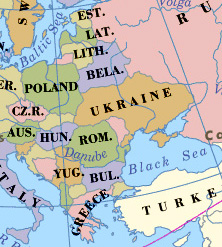Return
to Main Page
1 of 9
 Eastern
Europe is a very diverse region, consisting of a number of different countries.
The Eastern half of Germany defines one border, with Poland, the Czech
and Slovak Republics, Hungary, Romania, the former Yugoslavia, and now
the former Soviet Republics of Estonia, Latvia, Lithuania, Belorussia,
and the Ukraine comprising the area commonly known as "Eastern Europe."
The region historically has been lumped together because of its domination
by one of three vast pre World War I Empires, the Russian, Austro-Hungarian,
and Ottoman (Turkish) Empires. Also, in the inter war period (1919-1939),
the newly independent countries of Eastern Europe followed a similar pattern,
with weak parliamentary democracies giving way to fascist dictatorships
during the Great Depression of the 1930s and subsequently to German occupation
during World War II. Most of these countries, moreover, shared the
common fate of Soviet occupation during the Cold War period, Red Army troops
withdrawing only in the late 1980s. With the end of Soviet hegemony
and the Cold War, according to British historian Geoffrey Swain, we are
likely to witness at long last the individual development of the various
states of Eastern Europe, and soon it will be much more difficult to describe
"Eastern Europe" in terms of a single, unified region.
Eastern
Europe is a very diverse region, consisting of a number of different countries.
The Eastern half of Germany defines one border, with Poland, the Czech
and Slovak Republics, Hungary, Romania, the former Yugoslavia, and now
the former Soviet Republics of Estonia, Latvia, Lithuania, Belorussia,
and the Ukraine comprising the area commonly known as "Eastern Europe."
The region historically has been lumped together because of its domination
by one of three vast pre World War I Empires, the Russian, Austro-Hungarian,
and Ottoman (Turkish) Empires. Also, in the inter war period (1919-1939),
the newly independent countries of Eastern Europe followed a similar pattern,
with weak parliamentary democracies giving way to fascist dictatorships
during the Great Depression of the 1930s and subsequently to German occupation
during World War II. Most of these countries, moreover, shared the
common fate of Soviet occupation during the Cold War period, Red Army troops
withdrawing only in the late 1980s. With the end of Soviet hegemony
and the Cold War, according to British historian Geoffrey Swain, we are
likely to witness at long last the individual development of the various
states of Eastern Europe, and soon it will be much more difficult to describe
"Eastern Europe" in terms of a single, unified region.



 Eastern
Europe is a very diverse region, consisting of a number of different countries.
The Eastern half of Germany defines one border, with Poland, the Czech
and Slovak Republics, Hungary, Romania, the former Yugoslavia, and now
the former Soviet Republics of Estonia, Latvia, Lithuania, Belorussia,
and the Ukraine comprising the area commonly known as "Eastern Europe."
The region historically has been lumped together because of its domination
by one of three vast pre World War I Empires, the Russian, Austro-Hungarian,
and Ottoman (Turkish) Empires. Also, in the inter war period (1919-1939),
the newly independent countries of Eastern Europe followed a similar pattern,
with weak parliamentary democracies giving way to fascist dictatorships
during the Great Depression of the 1930s and subsequently to German occupation
during World War II. Most of these countries, moreover, shared the
common fate of Soviet occupation during the Cold War period, Red Army troops
withdrawing only in the late 1980s. With the end of Soviet hegemony
and the Cold War, according to British historian Geoffrey Swain, we are
likely to witness at long last the individual development of the various
states of Eastern Europe, and soon it will be much more difficult to describe
"Eastern Europe" in terms of a single, unified region.
Eastern
Europe is a very diverse region, consisting of a number of different countries.
The Eastern half of Germany defines one border, with Poland, the Czech
and Slovak Republics, Hungary, Romania, the former Yugoslavia, and now
the former Soviet Republics of Estonia, Latvia, Lithuania, Belorussia,
and the Ukraine comprising the area commonly known as "Eastern Europe."
The region historically has been lumped together because of its domination
by one of three vast pre World War I Empires, the Russian, Austro-Hungarian,
and Ottoman (Turkish) Empires. Also, in the inter war period (1919-1939),
the newly independent countries of Eastern Europe followed a similar pattern,
with weak parliamentary democracies giving way to fascist dictatorships
during the Great Depression of the 1930s and subsequently to German occupation
during World War II. Most of these countries, moreover, shared the
common fate of Soviet occupation during the Cold War period, Red Army troops
withdrawing only in the late 1980s. With the end of Soviet hegemony
and the Cold War, according to British historian Geoffrey Swain, we are
likely to witness at long last the individual development of the various
states of Eastern Europe, and soon it will be much more difficult to describe
"Eastern Europe" in terms of a single, unified region.